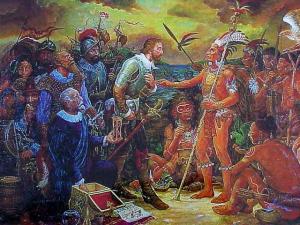During the prehistoric times, the Archaic Indians traveled in canoes from the Greater Antilles to our coasts, finding a paradise in Puerto Rico. Approximately 2,300 years ago; another progressive group of Indians, known as ignerus, came from South America. They were great sailors, potters and farmers and had roots with the Arawak culture that was originally from Orinoco, Venezuela. Years later, this culture evolved into the Taíno, meaning in the Arawak language “noble.” They named the small island Borinkén, translating to the land of God.
Honoring the communication they were able to have with the astral bodies that transit in the sky of Puerto Rico, they also worshiped Atabey, who they called Mother Nature. The Taínos gratefully reigned on the island, thanking Yocahú, their good God for being the creator of so much beauty. They feared Juracán and Maboya, the evil spirits who were the creators of catastrophes and disasters.

They considered the highest peak of El Yunque a sanctuary because they believed Yocahú lived there. They were able to understand the spiritual laws of the universe. They knew that their outer world just reflects their inner world. Through the communication and guidance they received from their ancestors and their gods, they peacefully lived on the island until the Spaniards settled in.
In 1493, When Columbus discovered Puerto Rico, the Taínos warmly and openly welcomed him. Christopher recorded in his journal that they were exotic Indians with beautiful thick and straight black hair. They had slender bodies and were medium height. Their facial features were refined, penetrating in their dark eyes, the wisdom of their souls. Their skin was hairless and tanned, showing their gentle nature in their smile and their tongue.

Upon the Spaniards arrival, about 40,000 Taínos inhabited the island. The main cacique, meaning chief was named Agueybaná. All the Indians respected him because he was a sagacious and honorable man. They lived in a tribe formed by nitaínos: Warriors and relatives of the cacique. The naborias were farmers that followed orders from the cacique. Each tribe had a bohíque, the most important person after the cacique, who was the wisest shaman of the community.
For being primitive Indians, they were very knowledgeable in astronomy, agriculture, medicine plants, geography, religion, textiles, and fishing, among others. As expert sailors, the Taínos were able to guide the Spanish mariners through the Caribbean Sea. At first, they believed the Spaniards had supernatural powers and were spiritually advanced, but it didn’t take long for them to see their true nature. In 1511, after the Taínos drowned Diego Salcedo, a Spanish warrior, they rebelled by declaring war to the soldiers.

Ricardo Jusino
During a confrontation with Ponce de León colonizers, Agueybaná got killed, becoming their paradise on earth a place of despair. Evil had invaded Their land of God, and they could no longer survive the Spanish tyranny. Upon Agueybaná’s death, some Taínos escaped into the forest, others canoed to near islands, and others committed suicide, preferring their death than living under those miserable conditions.

They carved symbols in the stones, known as hieroglyphs, encrypting through those codes the mysterious secrets, not defined yet. Even though they learned to defend themselves from the Carib aborigines, known as cannibals and very violent, the Spaniard exploitation was beyond their ability to survive their abuse. They were forced to do mining work and treated as slaves; therefore, in 1541, less than 4,000 Taínos were left on the island.
Five years later, after the African slaves were introduced to work in agriculture, the smallpox epidemic brought from Africa, killed many Spaniards and Taínos. At the expense of the African slaves and the Taínos, the Spanish built a prosperous empire in the new world.

Ricardo Jusino
Even though Puerto Rico was under the reign of Spain until it became part of the United States in 1898, its culture and history are rich in original Taíno words, incorporated in the name of many of the cities, foods, instruments, trees, and plants. They left a legacy of art through their sculptures and zemís, which were sculptures that encompassed the spirit of Yocahú. They hid most of their ceremonial artifacts from the Spanish in caves. Their primary foods were yucca, yautía, batata, and corn.
In 1542, Spain declared officially free the few Taínos left on the island. From there on, the indigenous embodied the Boricua. The spirit of these advanced and highly spiritual Indians rejoice the hearts of the proud Puerto Ricans, whose love for their country resemble the legacy of their ancestors.
18 thoughts on “The Indigenous Borincanos”